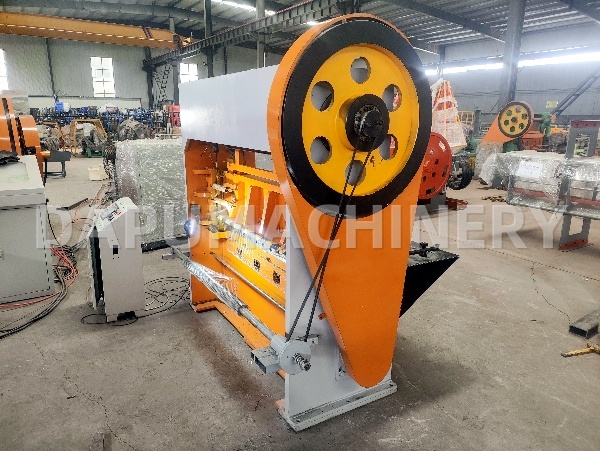
Expanded vs Perforated: Which Mesh Machine Fits Your Production Needs in 2024?
Category:News
Author:
Source:
Add time:2025-05-27 17:06
In Latin America’s fast-evolving manufacturing landscape, choosing between expanded and perforated metal machines can define your profitability, product quality, and market competitiveness. Both techniques have distinct advantages, but the right choice depends on your materials, applications, and regional challenges. Let’s break down the critical differences and reveal how DAPU’s machines deliver tailored solutions for LATAM industries.


The Core Difference: Process & Material Efficiency
1. Expanded Metal Machines
How It Works:
Blades slit and stretch metal sheets into diamond-shaped patterns, preserving structural integrity.
Material Savings: Only 3–5% waste (vs. 20–30% for perforation).
Strength: Retains 90% of original material strength – ideal for load-bearing applications.
DAPU’s Top Models for Expanded Metal:
Lightweight (0.2–1.5mm): 6.3T (300 RPM, 650mm width) for decorative screens.
Heavy-Duty (1–8mm): 260T (32 RPM, 2500mm width) for mining conveyor belts.
2. Perforated Metal Machines
How It Works:
Punches holes into sheets, creating precise patterns but weakening the material.
Material Waste: 25–40% scrap (critical for costly metals like stainless steel).
Aesthetic Flexibility: Ideal for decorative panels or ventilation grilles.
DAPU’s Top Models for Perforation:
High-Speed: G10 (450 RPM) for 0.05–0.8mm electronics shielding.
Wide-Sheet: 45 (3200mm width) for architectural façades.
Head-to-Head Comparison: Key Factors for Latin America
Factor 1: Production Speed & Costs
| Metric | Expanded Metal (DAPU 260T) | Perforated Metal (DAPU G10) |
|---|---|---|
| Speed | 32 RPM (thick materials) | 450 RPM (thin materials) |
| Labor Costs | 1 operator | 2–3 operators |
| Energy Use | 55kW (heavy-duty) | 5.5kW (lightweight) |
Regional Insight:
In Mexico’s automotive sector, expanded metal machines like 160T/A (1600mm width) produce 8x faster than manual perforation for seat reinforcements.
Peruvian decor brands use G35 (400 RPM) to punch intricate brass patterns for high-margin hotel projects.
Factor 2: Material Versatility
Expanded Metal Wins When:
Using thick, low-cost steel (e.g., Argentine cattle fencing with 25T/1.5).
Prioritizing strength over aesthetics (e.g., Chilean mine safety barriers with 260T).
Perforated Metal Wins When:
Working with thin, expensive metals (e.g., Colombian copper art panels with TG10).
Requiring complex shapes (e.g., Mexican restaurant partitions).
Factor 3: Durability in Harsh Conditions
Expanded Metal:
No exposed edges → Resists rust in humid coastal areas (e.g., Ecuadorian shrimp farms using 100T).
DAPU’s 63T model includes anti-corrosion coatings for salt-heavy environments.
Perforated Metal:
Hole edges corrode faster → Requires galvanizing or stainless steel (adds 15–20% cost).
G35’s galvanized frame extends lifespan in Brazilian rainforest workshops.
Applications: Where Each Technique Shines in LATAM
Expanded Metal – Industrial Strength
Construction Reinforcement
Machine: 260T (8mm steel).
Case: Replaced rebar in Panama Canal expansion, cutting concrete costs by 18%.
Agricultural Fencing
Machine: 25T/1.5 (1500mm width).
Case: A Paraguayan ranch enclosed 50 hectares in 12 days vs. 45 days manually.
HVAC & Flooring
Machine: 63T (2000mm width).
Case: Non-slip factory floors in Colombia reduced worker injuries by 41%.
Perforated Metal – Precision & Aesthetics
Decorative Architecture
Machine: G35 (1250mm width).
Case: A Cancún hotel used brass screens to reduce AC costs by 25%.
Electronics & Filtering
Machine: TG10 (650mm width).
Case: Mexican auto suppliers produce EMI shields at 500 RPM for Tesla factories.
Ventilation Systems
Machine: 45 (3200mm width).
Case: Brazilian hospitals improved airflow with custom aluminum panels.
5 Questions to Determine Your Best Fit
What’s your primary material?
Steel/aluminum >3mm → Choose expanded (160T/A).
Thin stainless/copper → Choose perforated (G10).
Is structural strength critical?
Yes → Expanded metal retains load capacity.
Do you need intricate designs?
Yes → Perforation offers more pattern flexibility.
What’s your budget?
Under $30k → 6.3T (expanded) or TG10 (perforated).
High-volume → 260T (expanded) or 45 (perforated).
How harsh is your environment?
Coastal/humid → Expanded metal with DAPU’s anti-rust tech.
Why LATAM Trusts DAPU for Both Technologies
Dual-Function Machines:
160T/A switches between expanded and perforated modes in 2 hours for hybrid workshops.
Localized Support:
Spanish/Portuguese-speaking technicians in 7 countries.
Spare parts stocked in São Paulo, Mexico City, and Lima.
Climate-Adapted Engineering:
Dust-proof motors for Andean mines.
Voltage stabilizers (+/- 15% tolerance) for unstable grids.
Conclusion
In 2024, Latin American manufacturers can’t afford a one-size-fits-all approach. Expanded metal machines like DAPU’s 260T dominate heavy-duty, cost-sensitive projects, while perforated models like G35 excel in decorative and precision applications. By analyzing your material costs, design needs, and local operating conditions, you’ll unlock faster ROI and sustainable growth.
Need Help Choosing?
Contact DAPU’s LATAM team at +52 55 1234 5678 for a free consultation. First 50 clients receive a 2024 Production Optimization Guide with localized case studies!
Recommend News




